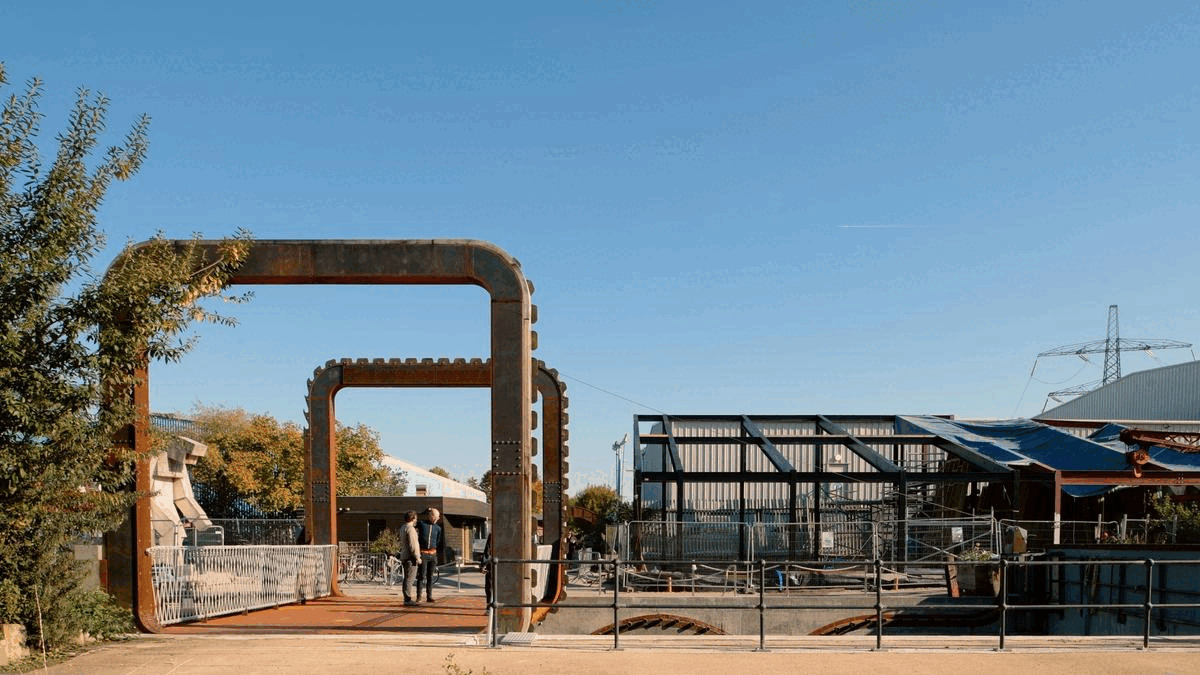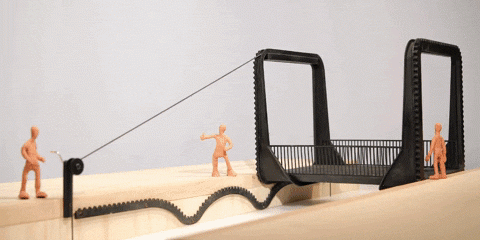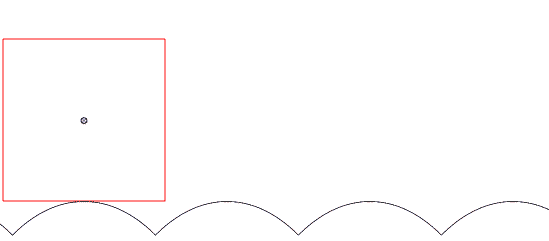本文由 Thomas Randall-Page 授权mooool发表,欢迎转发,禁止以mooool编辑版本转载。
Thanks Thomas Randall-Page for authorizing the publication of the project on mooool, Text description provided by Thomas Randall-Page.
Thomas Randall-Page:位于伦敦东部利河畔的科迪码头(Cody Dock)曾是一个大型工业码头。现在则成为了一个充满活力的艺术家乐园,艺术家们正在将这个地方从被遗弃之地转变为一个创意和生产的绿洲。
其中一个关键部分是将码头重新开放并连接利河的潮汐水域,使其可以用于停泊,而这需要拆除大坝并引入开放式人行天桥。这座新的人行天桥将承载“Leaway”步道和自行车道,以及 “The Line”雕塑步道。
废弃的码头目前阻碍了行人和骑行者进入一条壮观的绿色走廊,该走廊从赫特福德郡穿过沃尔瑟姆修道院和奥林匹克公园,最后到达泰晤士河。
Thomas Randall-Page: Cody Dock is a huge ex-industrial dock located on the bank of the Lea river in east London. The Dock is now home to a dynamic community of artistic people who are in the process of transforming the place from dereliction into an oasis of creativity and production.
A key part of this is reopening the dock to the Lea’s tidal waters so it can be used for moorings, this requires the removal of a dam and the introduction of an opening foot bridge. This new foot bridge will carry the ‘Leaway’ footpath and cycle route and also ‘The Line’ Sculpture walk.
The derelict dock currently acts as a barrier to pedestrians and cyclists accessing an amazing green corridor which runs from Hertfordshire, through Waltham Abbey and the Olympic Park, before ending at the Thames.
码头历史 History
科迪码头最初建于1871年,由帝国化学工业公司建造,目的是从驳船上卸载煤炭,用于生产煤气(城镇煤气),并分销工厂的许多副产品,如肥皂和普鲁士蓝颜料。该码头后来被Gaslight and Coke公司收购,该公司还拥有贝克顿煤气厂,后者成为了欧洲最大的煤气厂。
在被英国天然气公司接管后,码头及其相关厂房从上世纪60年代末开始衰落,所有的生产都在80年代初停止。90年代初,科迪码头和周围的房产被码头区开发公司(Docklands Development Corporation)接管,周围的大部分土地被分割出来,重新开发成今天仍然存在的商业园区。然而,码头不再被认为是可利用的,并被封锁,部分被填埋,被改造为一个用于处理地表径流的平衡泻湖。
2009年11月,当地居民成立了慈善机构Gasworks Dock Partnership(GDP),这是一个非营利组织,旨在以社区为主导进行再开发,目的是开放通往利河下游的公共通道并修复码头。
Originally built in 1871, Cody Dock was constructed by the Imperial Chemical Company for the purpose of unloading coal from barges that was used to produce coal gas (town gas) and distribute the factory’s many by-products, such as soap and the pigment Prussian Blue. The dock was later purchased by the Gaslight and Coke Company who also owned the Beckton gasworks which became the largest gasworks in Europe.
After being taken over by British Gas, the dock and its associated factory buildings fell into decline from the late 1960’s with all production coming to a close in the early 1980’s. Cody Dock and the surrounding properties were taken over by the Docklands Development Corporation in the early 90’s and much of the surrounding land was parcelled off for redevelopment into the business parks that still remain today. The dock, however, was no longer seen as being viable and was blocked off, partially filled in and converted into a balancing lagoon for surface water run-off.
In November 2009 the charity Gasworks Dock Partnership was formed by local residents as a not-for-profit organisation, to provide a community led regeneration vehicle with the aim of opening up public access to the Lower Lea River and restoring the dock.
码头重建 Redevelopment
“GDP”于2009年11月作为一家社会企业成立,并于2011年4月注册为慈善机构。
从2015年到2018年,“GDP”向超过5万名游客开放了科迪码头的大门,并与6000多名志愿者一起清理和修复了河边的人行道。 在泰晤士河水务公司、Veola环境信托基金、邱园、皇家园艺协会、纽汉姆委员会和大乐透的支持下,科迪码头已成为社区主导修复再生的旗舰载体。
The Gasworks Dock Partnership was formed as a social enterprise in November 2009 and registered as a charity in April, 2011.
From 2015 – 2018, GDP opened Cody Dock’s gates to over 50,000 visitors and worked with over 6,000 volunteers on the clean up and restoration of its riverside footpaths. With support from Thames Water, the Veola Environmental Trust, Kew Gardens, the Royal Horticultural Society, Newham Council and the Big Lottery, Cody Dock has established itself as a flagship vehicle for community-led regeneration.
随着一期工程的完成和Leaway River Lea公园的启动,科迪码头已经成为许多创意产业、社会企业和旅游景点的所在地,其中包括:码头区社区船、科迪码头咖啡馆、画廊和展览空间、户外教室、工作室空间。
2018年4月,“GDP”成功获得规划许可,将其2.5英亩的土地开发为创意产业区,制定了一个七年发展计划。这将包括:新的游客中心和咖啡厅、展览空间、社会和工业遗产档案和展馆、国际艺术家和临时托管套房、10个新的工作室和车间空间、10个新的生活/工作停泊点、游客停泊点、干船坞设施。
With Phase One complete and the Leaway River Lea Park now kick started, Cody Dock is already home to a number of creative industries, social enterprises and visitor attractions, that include:
• Docklands Community Boat
• Cody Dock Cafe
• Gallery and exhibition space
• Outdoor classroom
• Studio spaces
In April 2018, GDP successfully gained planning permission for the seven year development plan of its 2.5 acre site into a creative industries quarter. This will include:
New visitor centre & café
Exhibition space
Social and Industrial heritage archive and pavilion
International artist and respite hosting suites
10 new studios and workshop spaces
10 new live/work moorings
Visitor moorings
Dry dock facilities
桥的故事 Story of the bridge
作为重建和修复科迪码头宏伟愿景的一部分,煤气厂码头合伙公司已经申请并获得了在码头关键部位建造开放式人行桥的规划许可。这一最初的计划涉及从荷兰采购的现成产品开放吊篮式桥梁。
设计师托马斯·兰德尔·佩奇(Thomas Randall Page)听到了这些计划的风声,并联系了“GDP”表明看看他是否能提出更独特的方案。他认为这座桥是整个项目的重要核心,是两岸和码头之间的两个门槛的守护者。因此,这种基础设施应该是值得庆祝和纪念的,是人们来了就会看到而不会错过和忘记的东西。
托马斯随后乘坐运河船进行了为期两周的缓慢旅行,他花时间绘制草图,也会停下来帮忙修船闸。之后他带着一种新型开放式桥梁的想法回来了,并把它交给了Price & Myers公司出色的结构工程师蒂姆·卢卡斯(Tim Lucas),让他确认该方案是否可行。蒂姆很喜欢这个想法,并借助模型,托马斯将该想法提交给了“GDP”的西蒙·迈尔斯(Simon Myers)。
西蒙被这个想法迷住了,他最后改变了策略。
As a part of the big vision to regenerate and restore Cody Dock, Gasworks Dock Partnership had applied for and been granted planning permission for an opening foot bridge at the neck of the dock. This original plan involved an off-the-shelf product opening bascule-type bridge sourced from the Netherlands.
Designer Thomas Randall Page got wind of these plans and approached GDP to see if he could counter propose something more unique. He suggested that the bridge was an important centrepiece for the whole project, the keeper of two thresholds, bank to bank and also river to dock. As such this infrastructure should be celebrated and memorable, something people would come and see not cross and forget.
Thomas then went on a slow 2 week journey on a canal boat and spent his time sketching only stopping to help with the locks. He returned with an idea for a new type of opening bridge and took it to Tim Lucas a fantastic structural engineer at Price & Myers to pass an eye over it and see if it “had legs”. Tim loved the idea and with the help of a model Thomas pitched it to Simon Myers at GDP.
Simon was taken enough with the idea that he changed tack and the rest is history.
▽前后滚动 Roll back and forth
▽开场动作动画 Opening action animation
设计师托马斯表示:升高、摆动、滑动、折叠、倾斜…….解决开放式桥梁挑战的方法多种多样。
看到桥梁开放所固有的公共景观的潜力,我开始着力推进此提议。
这座独一无二的桥梁设计与它穿过的海峡平行,这在很大程度上要归功于维多利亚时代的前辈。他们知道,有效地移动大型重型结构需要一个平衡系统,我的设计就是基于这个原则。
Designer’s statement
raising,
swinging,
sliding,
folding
and tilting …….
the solutions to the challenge of the opening bridge are many and varied.
Seeing the potential for public spectacle inherent in the opening of a bridge, I set about adding to this list of motions.
Rolling parallel to the channel it crosses, this unique bridge design owes much to its Victorian forbears. They knew that moving large heavy structures efficiently requires that they are balanced system and my design works on this principle.
跨度两端的方齿形入口在与砖桥台相连的起伏轨道上滚动。
每个入口顶部的配重平衡连接它们的桥面。这种对称性使整个桥梁结构能够平稳地通过180度达到完全倒置的位置,便于船只从河流到码头来回通行。这个系统的平衡性非常好,不需要马达或电力,可以像运河船闸一样手动操作。
这座桥由耐候钢和橡木建造而成,其设计目的是在其静止状态保持低调,但在其运动时又具有庆祝性和趣味性,在运行时创造一个能吸引观众的和令人难忘的事件。作为横跨利河全长的步道和自行车道项目的一部分,我们希望这座滚动桥将成为一个重要的地标,并成为这里蓬勃发展的创意社区的象征。
Square toothed portals at each end of the span roll on undulating rails attached to the brick abutments.
Counterweights at the top of each portal balance the bridge deck that connects them. This symmetry allows the whole bridge structure to smoothly role through 180 degrees to a fully inverted position facilitating the passage of boats back and forth from the river to the dock. So finely balanced is this system that it requires no motors or electricity and can be operated manually much like a canal lock.
Constructed from weathering steel and oak, the bridge design aims to be understated in its rest position but celebratory and playful in its movement creating a spectator and memorable event when operated. Part of an ambitious footpath and cycleway project to run the full length of the Lea River, we hope this rolling bridge will become an important landmark and a symbol of the dynamic creative community which is growing here.
这座桥重13吨,栏杆被设计成可以平折到甲板上,以便在桥梁倒置时提供额外一米的空间,让船只通过。
每个栏杆的顶部都填充了废钢和混凝土压载物的混合物,以平衡桥面的重量。重力中心就在两个传送门的中心之间。随着桥的滚动,重心水平移动。
整座钢桥由Cake Industries公司在伦敦南部的Sydenham建造,并由2辆卡车分成4大块运至现场。橡木承重面的拐角是由坎布里亚郡的Charlie Whinney特意利用蒸汽从直线部分弯曲而成的。
这个自发的项目到目前为止已经开发了7年。
The bridge weighs 13 tonnes. The balustrades are designed to fold flat to the deck to give an extra meter of air-draft when the bridge is inverted to let boats through.
The tops of each hoop are filled with a mixture of scrap steel and concrete ballast to balance the weight of the bridge deck.The centre of gravity is directly between the centres of the two portal hoops.The centre of gravity moves horizontally as the bridge rolls.
The whole steel bridge was fabricated in Sydenham in South London by Cake Industries and brought to site in 4 large pieces on 2 lorries. The oak bearing surfaces have corners which were specially steam bent from straight sections by Charlie Whinney in Cumbria.
This self-initiated project has been in development for 7 years.
▽桥梁滚动时重心保持水平移动 Rolling
▽桥梁细节 Detail
▽设计图纸 Design drawing



项目名称:The Cody Dock Rolling Bridge
设计:Thomas Randall-Page
结构工程:Price and Myers
机械工程:Eadon Consulting
制造和安装:Cake Industries
弯折橡木:Charlie Whinney Studio
资助:The National Lottery Heritage Fund
Project Name: The Cody Dock Rolling Bridge
Design: Thomas Randall-Page
Structural Engineering: Price & Myers
Mechanical Engineering: Eadon Consulting
Fabrication and Installation: Cake Industries
Oak bending – Charlie Whinney Studio
Funding: The National Lottery Heritage Fund
“ 融合创意、功能和互动参与的独特地标设计,一座可以翻滚的桥梁。”
审稿编辑:SIM
更多 Read more about:Thomas Randall-Page
















































0 Comments